Article's Content
Welcome to Volume 75
How often do you celebrate little wins?
Sometimes we get so hyper-focused on the big picture that we forget the pixels that make up the picture. We forget to enjoy the process and the little wins along the way.
If you keep postponing your happiness until you feel you’ve achieved a major milestone, you might never be happy. And when you hit that major milestone, you’ll find yourself dissatisfied and wanting more.
So, make a promise to yourself.
At the end of every day or week, depending on which you prefer, celebrate your wins.
If you wanted to hit the gym three days a week, and you made it only once, celebrate that little step you made. Acknowledge that win then strive to do better next week.
That’s how you stay happy, energized, and productive every single day.
Before we dive into today’s stories, here’s a peek at what’s to come in this piece:
- Calm Business’s SEO & Content Strategy
- What Google’s $5.4 Billion Acquisition Means
- Stripe Targets Crypto Market
Calm Business’s SEO & Content Strategy
Half of employees quit their jobs in 2021 because of their mental health.
Calm is a brand that advocates and creates solutions that promote mental wellness. The meditation and sleep app started out as a solution for individuals looking to improve their health and happiness. And they have been successful in their attempt.
Valued at $2B, the company’s website attracts over 200K monthly search traffic, with the majority landing on the homepage, probably to use the app to improve their health. Here’s what their search scorecard looks like:
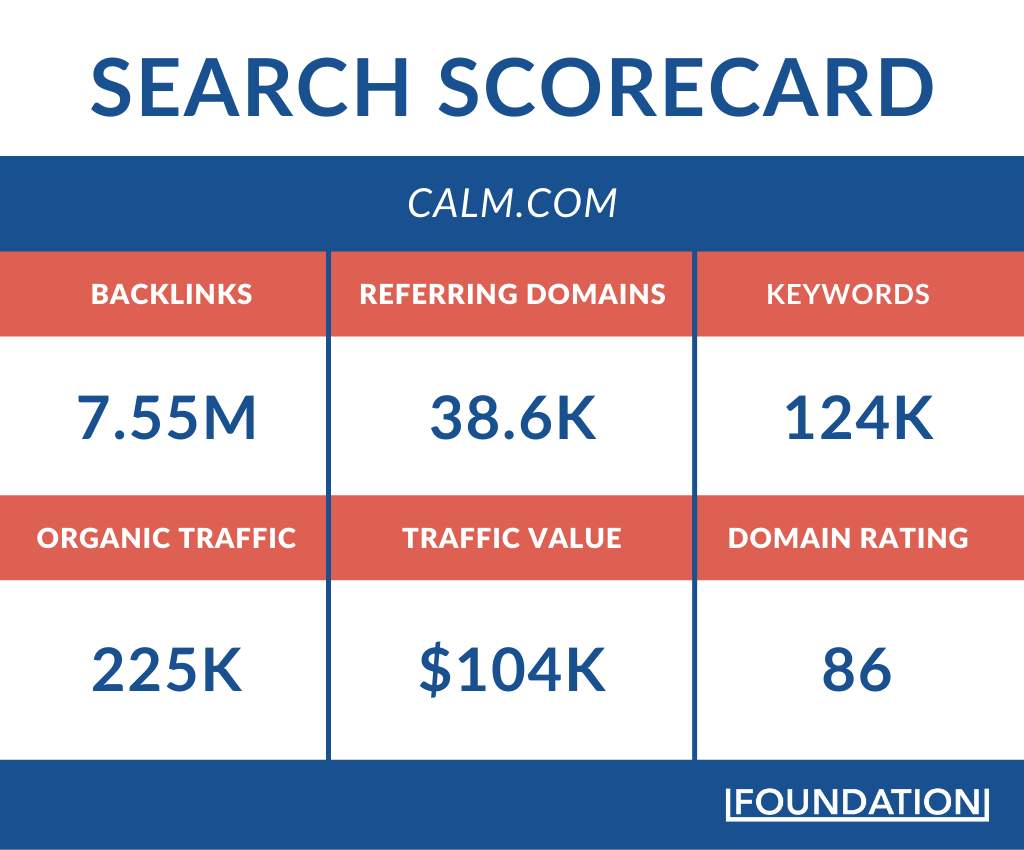
Recently, Calm expanded its offerings to serve a new market segment—the workplace. Calm Business targets organizations to help build resilience and promote wellness.
Since its launch, over 1500 organizations, including GoFundMe, Accenture, Lincoln, and Universal Music Group rely on Calm Business to build a resilient organization.
Calm business’ success so far made me go digging to see the role content marketing is playing overall. Here’s what I found:
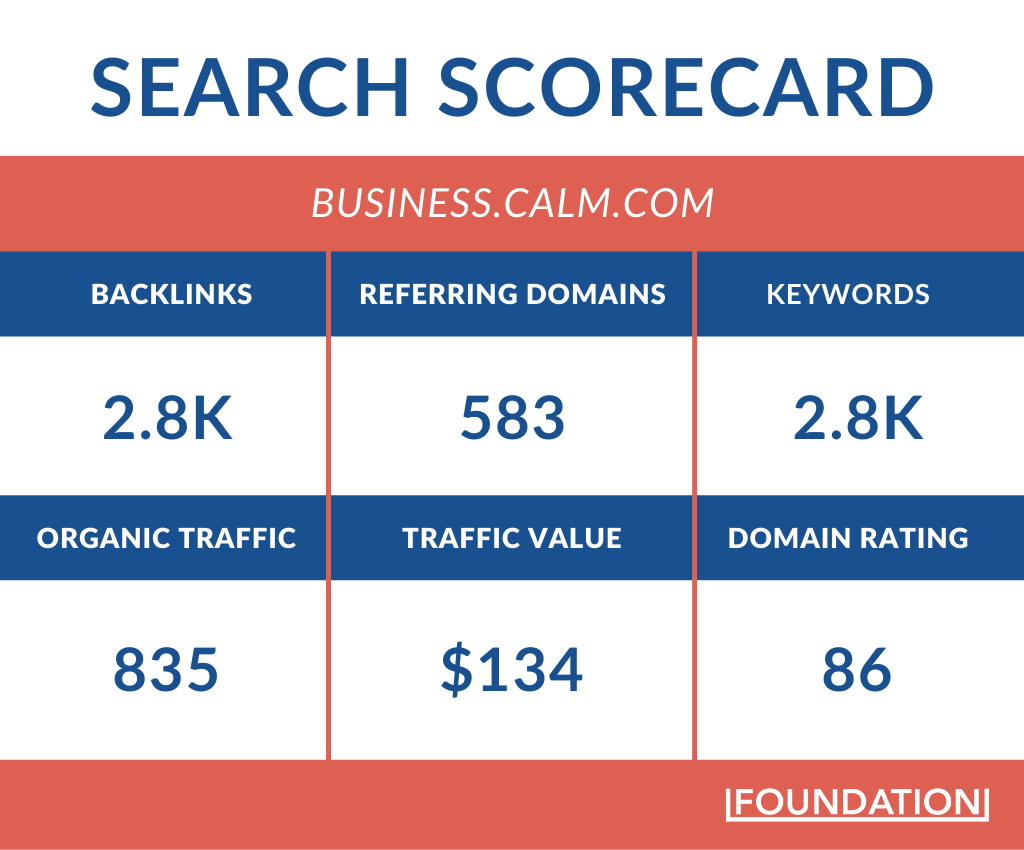
Apparently, Calm Business isn’t generating nearly as much traffic or backlinks as its mother site.
At first glance, one would say the business side of the app is feeding off the company’s already established reputation. That’s why companies trust the app.
However, Rome wasn’t built in a day. It takes years of consistent effort to build something sustainable and successful.
Calm had 10 solid years to establish their authority, and they are still succeeding.
They started with a single asset and a much smaller audience. However, with consistent efforts, they have achieved massive success.
Calm Business, on the other hand, is a relatively new brainchild that is already making great strides towards success.
Ross did a full teardown on Calm Business in which he broke down the key marketing strategies the company is using to succeed in organic search.
One of the strategies Ross called out was Calm Business’s investment in creating backlink-driven assets.
Take this asset, for example:
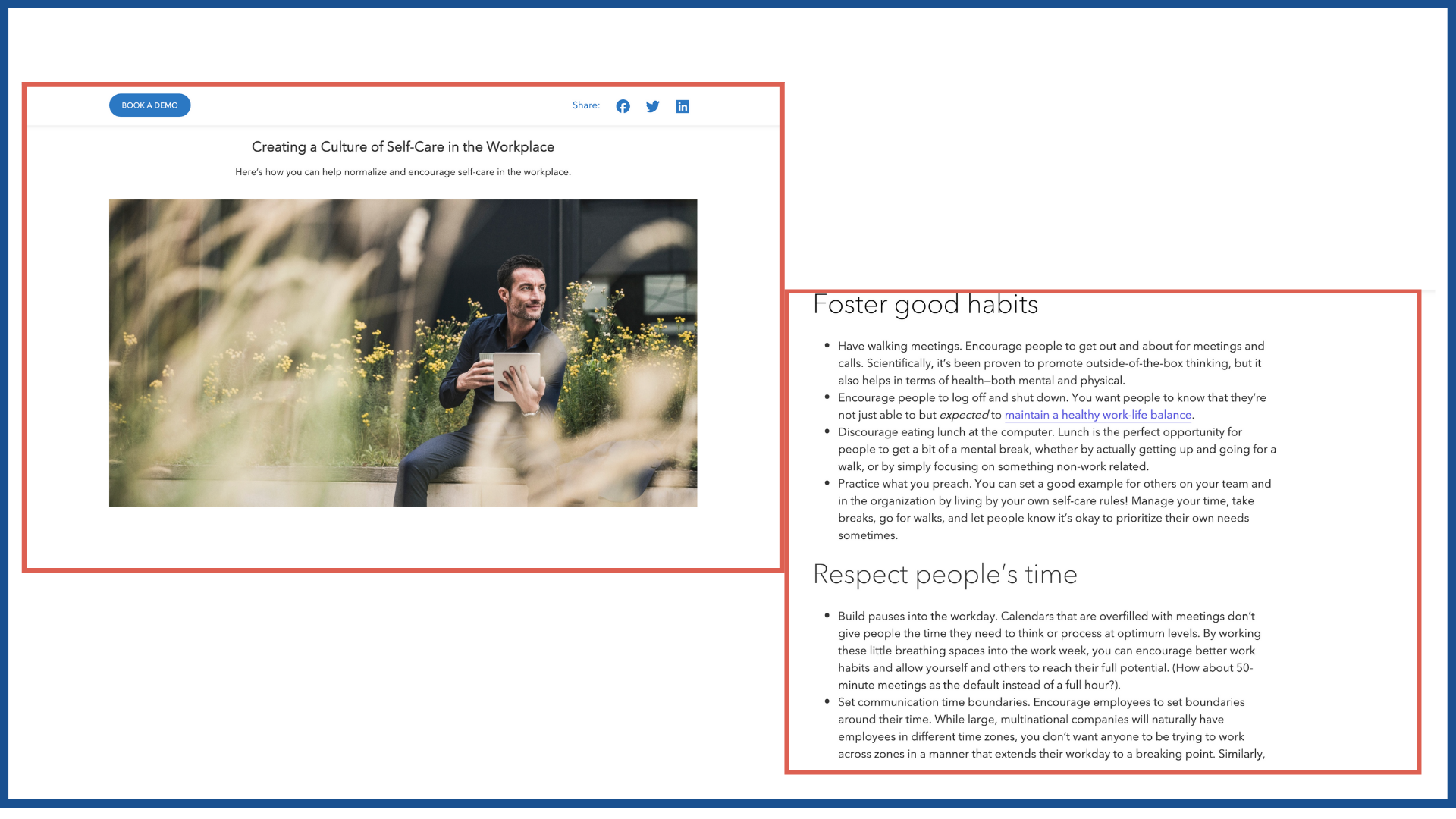
The guide “Creating a Culture of Self-Care in the Workplace” has attracted 110 backlinks since it was published less than five months ago.
What makes the content piece so relevant is that it speaks directly to one of the pain points of Calm Business’s target audience: how organizations can create a culture that keeps employees from burning out or jumping ship.
They also grabbed the number spot on the SERPs for the long-tail keyword, “Self-care in the workplace.”
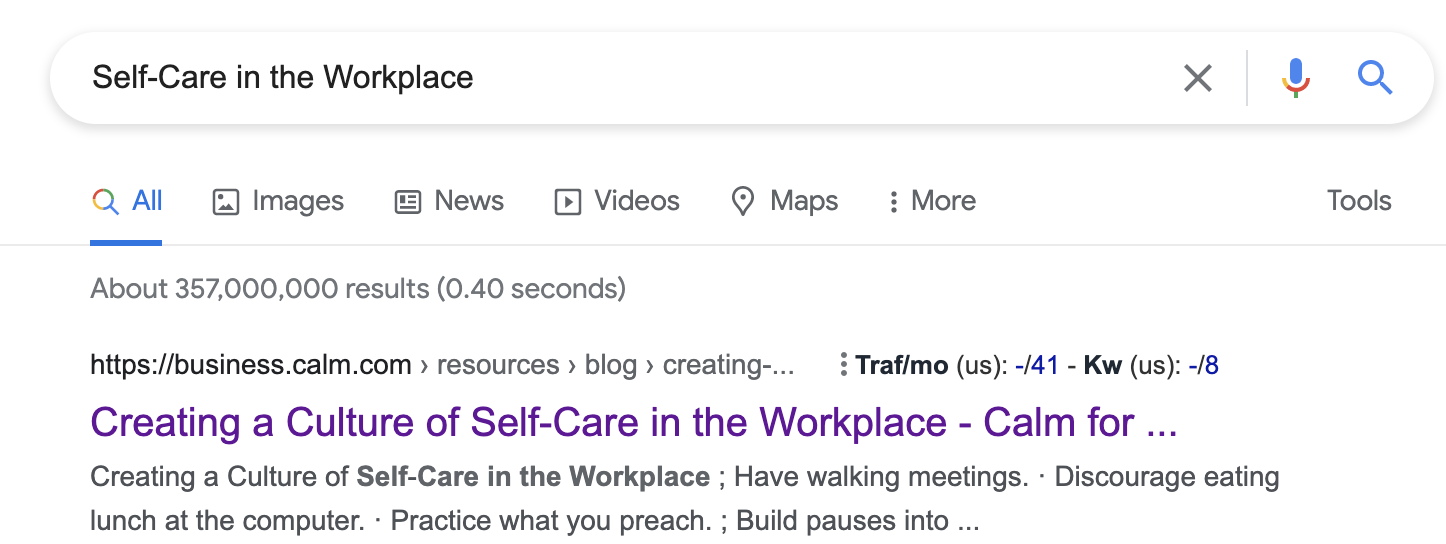
For a blog that’s just starting out, choosing long-tail keywords is a great SEO strategy.
This keyword may get less search traffic, but they have higher intent and conversion value. In other words, Calm Business is more likely to attract high-quality traffic to their website that could potentially become customers.
There are several other ways Calm Business is working hard towards dominating the SERPs and establishing authority. You can learn more about these strategies in the full case study Ross created.
KEY TAKEAWAYS:
- Valued at $2 Billion, Calm attracts over 200K monthly search traffic, with the majority landing on the homepage to use the app to improve their health.
- Calm Business serves over 1500 organizations looking to build resilience and promote wellness in the workplace.
- Calm Business creates backlink-driven assets by targeting long-tail keywords and ensuring the resource solves their audience’s critical pain points.
What Google’s $5.4 Billion Acquisition Means
Last week, we talked about LinkedIn’s acquisition of Oribi, and what it means for the B2B industry. Over the course of the week, another blockbuster acquisition happened.
Google acquired Mandiant in an all-cash deal valued at approximately USD$5.4 billion. Google Cloud’s CEO Thomas Kurian explains the goal for the acquisition, “We look forward to welcoming Mandiant to Google Cloud to further enhance our security operations suite and advisory services, and help customers address their most important security challenges.”
Mandiant is known for uncovering cybersecurity attacks such as APT1’s enterprise-scale computer espionage campaign and the SolarWinds hack.
Security is to the cloud as media is to marketing. This isn’t to say security isn’t important to us marketers. But if the cloud where we store our files isn’t safe, we risk losing everything we have worked so hard to build.
Perhaps that’s why the acquisition is one of the largest deals in the company’s history—the desire to build a more secure system.
Beyond securing users’ files, another reason for this acquisition is the cloud wars and Google’s attempt to move up the ladder.
Currently, Amazon leads the $180 Billion cloud market, with Google Cloud in third place. See what the market share looks like:
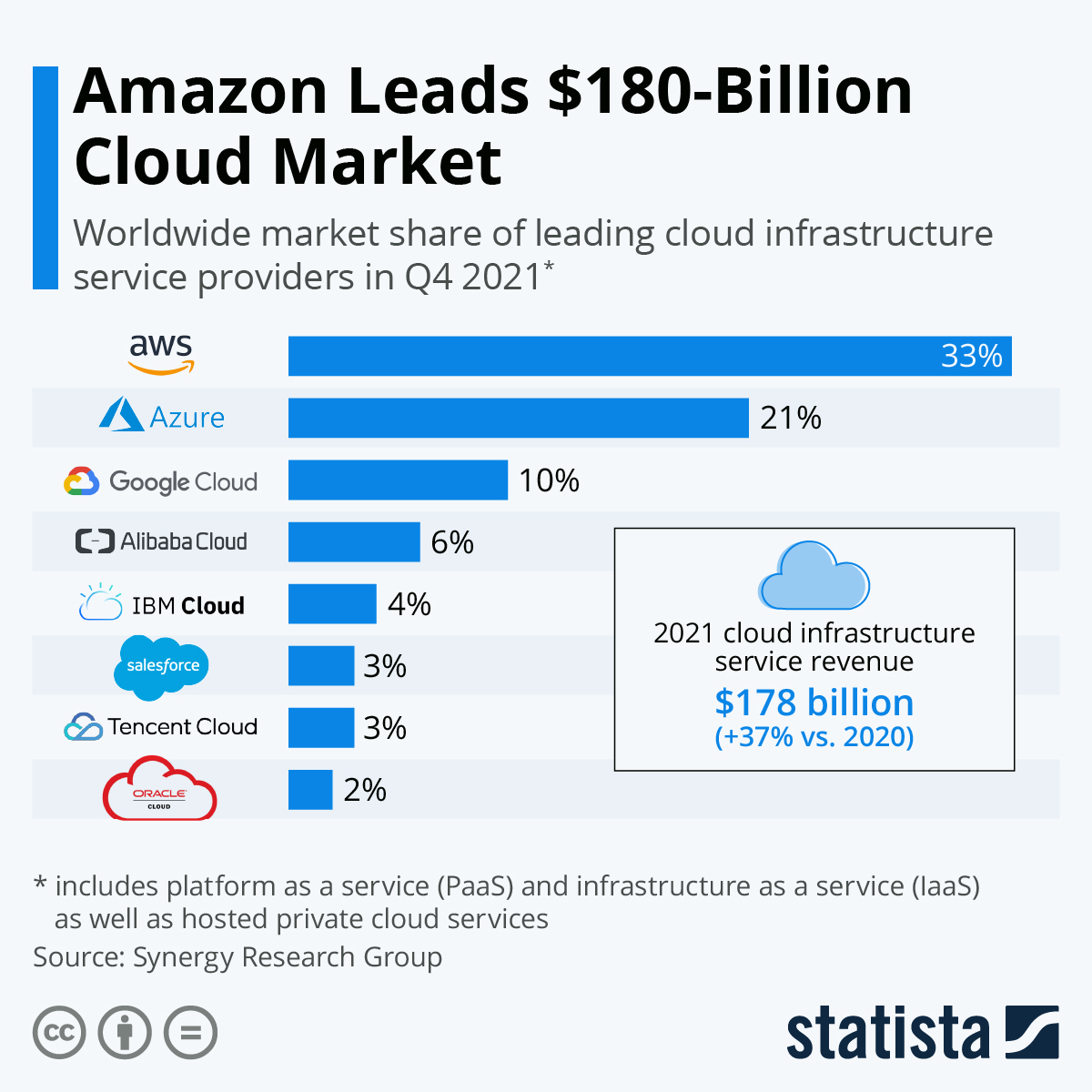
With the 600% increase in cybersecurity attacks, strengthening their security offering can be the differentiator Google Cloud needs to move higher up the ladder. Mandiant isn’t the first move Google has made in this direction.
In January, Google Cloud acquired Siemplify for about $500M to help companies detect, manage, and respond to threats better. Google Cloud also collaborated with CrowdStrike to roll out product integrations to boost security.
These acquisitions and integrations give Google Cloud a better chance at competing with Microsoft and Amazon. It all depends on how well they execute.
Google also exemplifies the mantra, “if you can’t build it, buy it.”
Instead of spending thousands of man-hours trying to build a rock-solid security system, Google is investing billions of dollars acquiring security companies along with their teams to strengthen what they already have.
KEY TAKEAWAYS:
- Google acquired Mandiant in an all-cash deal valued at approximately USD$5.4 billion to help customers address their most important security challenges.
- With the 600% increase in cybersecurity attacks, strengthening their security offering can be the differentiator Google Cloud needs to own the cloud.
- B2B SaaS companies should invest in seeking out companies with great potential or proven success, offering products/services complementary to theirs, instead of trying to build from scratch.
Stripe Targets Crypto Market
Recently, Stripe partnered with FTX and Blockchain.com to roll out crypto payments on their platform. This isn’t the first time Stripe is supporting crypto payments.
Stripe was the first on the scene in 2014 to support crypto via their payment system, but they shut it down in 2018. Now, they’re jumping back in to solve a major problem: the fear of sending money to the wrong address and high gas fees.
Stripe’s co-founder, John Collison, announced how the company plans to support crypto businesses:

Jumping on the Web3 train and rolling out solutions in advance, despite reservations about the technology, reinforces Stripe’s position as a forward-thinking brand.
Over the last decade, Stripe has consistently launched thriving products people love. Their innovation and tactfulness are two of the reasons why Stripe is the third most valuable company in the world, worth $95 Billion.
As marketers, another reason we love Stripe is its content and design excellence. Stripe has built an SEO moat that attracts over 2M monthly visitors. Here’s what their search scorecard looks like:

Fifty percent of the website’s traffic comes from referrals and organic search.
Stripe has built a library of useful content and API documentation that attracts backlinks from high-quality websites.
Stripe’s blog generates almost 10K monthly organic traffic, and their technical documentation attracts over 200K monthly sessions and over 1M backlinks.
They embrace the following approach to creating API documentation:
- Create first for people
- Optimize for search
- Embrace simplicity
- Make the home page user-friendly
- Make content valuable and actionable
If you serve a technical audience, API documentation is a gold mine. It shows how committed your brand is to supporting users through their journey. It also makes prospects see your solution as easy to use, and you’re more likely to convert them.
KEY TAKEAWAYS:
- Stripe partnered with FTX and Blockchain.com to roll out crypto payments on their platform.
- Jumping on the Web3 train and rolling out solutions in advance reinforces Stripe’s position as a forward-thinking brand.
- Stripe has built a library of useful content and documentation that has attracted over 800K backlinks from high-quality websites and 2M monthly organic traffic.
- API documentation is a gold mine for SaaS companies that serve a technical audience. It shows users how your solution solves their problems and increases your chances of converting prospects.
OTHER NEWS OF THE WEEK:
- HubSpot is now in Toronto, Canada, and they plan to hire more than 50 people in the province.
- TikTok has made Vamp, the global influencer marketing and content creation platform, an official marketing partner.
- Remember Limewire? Well, they’ve been reborn as an NFT Marketplace.
BRAIN FOOD OF THE WEEK:
People talk a lot about the comfort zone and its effects, but don’t talk enough about the “arrival mentality.”
While the comfort zone is a place for people who feel afraid or see no need to do anything extraordinary, an arrival mentality is a headspace where great achievers go to die.
When you believe you’ve arrived at a destination, you stop trying.
You stop trying to learn something from every situation.
You stop asking questions.
You stop doing the things that got you to your current level.
You somehow believe you’ve done enough, and your success is self-sustaining.
The danger with the arrival mindset is that it is so subtle that if you aren’t self-aware, you might miss it. The best way to fail in life is to stop trying and do nothing.
A progress mindset is the best mentality to build. It’s the mindset of a lifelong learner—one who learns from every situation to improve their lives and impact others.
No matter the heights you attain in life, you should never assume you know it all. There’s so much to learn, and you limit your chances of growing when you hang your boots too early.
TWITTER THREAD OF THE WEEK:
11 tips to improve your email marketing by Joe Portsmouth
IN CASE YOU MISSED SOME OF OUR GREATEST HITS:
- How Outreach Is Using Employees & Empowerment To Win on LinkedIn
- Write Better Headlines, From The Pros At LinkedIn
- Ross Simmonds on Content Marketing and Hustle Culture
- Gong’s LinkedIn Strategy: Breaking Through Social Media Noise
WHAT WE’RE WIRED INTO THIS WEEK 🎧:
These round-ups are brought to you by me, Jessica O., every week ✌!







